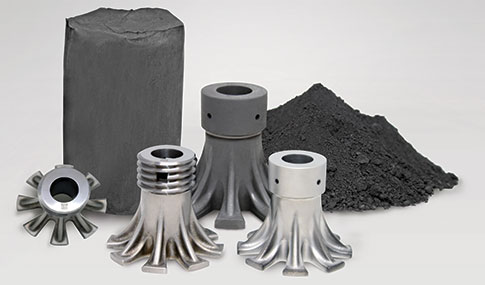Premium Grades of Tungsten Carbide to Improve Tooling Life
At General Carbide, our strength is making superior tungsten carbide tooling and wear parts, precision machined dies, punches and specialty components for customers in a wide range of industries, including automotive, oil & gas and ammunition tooling manufacturing.
We do it by working together with our customers to recommend the ideal grade for their specific applications. Our Application Engineers have the knowledge and expertise to make the right choice for your needs.
Much of our process consists of us performing extensive metallurgical and non-destructive testing to make carbide parts that perform as expected, or even better.
Several of our grades have TaC (tantalum carbide) & Cr3C2 (chromium carbide). The most popular grades in this group are:
- GC-813CT
- GC-411CT
- GC-425CT
- GC-613CT
- GC-618CT
- GC-0004
 GC-813CT’s multigrain carbide matrix, coupled with medium binder content, provides an excellent wear resistant grade at reasonable impact resistance. Our use of tantalum carbide allows GC-813CT to efficiently withstand galling which often occurs during stamping of cold rolled steels or stainless steels and provides thermal edge deformation resistance.
GC-813CT’s multigrain carbide matrix, coupled with medium binder content, provides an excellent wear resistant grade at reasonable impact resistance. Our use of tantalum carbide allows GC-813CT to efficiently withstand galling which often occurs during stamping of cold rolled steels or stainless steels and provides thermal edge deformation resistance.
As a corrosion-resistant additive, chromium carbide exhibits high resistance to binder leaching during electrical discharge machining (EDM) processes and prevents latent, residual corrosion that may occur on the working surfaces of tools being stored for future use.
Typical applications for GC-813CT include lamination tooling, stamping punches, dies and powder metal tooling.
.jpg?width=171&name=GC-411CT-(171w).jpg) GC-411CT has a relatively coarse carbide particle grain size. Coupled with medium binder content, it provides a wear resistant grade with moderate resistance to impact. The addition of tantalum carbide ensures the highest resistance to galling. Because chromium carbide is corrosion-resistant, it’s highly resistant to binder leaching during EDM. It also prevents latent, residual corrosion that may occur on the working surfaces of tools being stored for future use.
GC-411CT has a relatively coarse carbide particle grain size. Coupled with medium binder content, it provides a wear resistant grade with moderate resistance to impact. The addition of tantalum carbide ensures the highest resistance to galling. Because chromium carbide is corrosion-resistant, it’s highly resistant to binder leaching during EDM. It also prevents latent, residual corrosion that may occur on the working surfaces of tools being stored for future use.
Common applications include: heavy stamping and lamination punches and dies; powder metal dies; and pierce punches and dies.
 GC-425CT is a mixture of intermediate carbide grain sizes. Coupled with its higher binder content, GC-425CT can withstand the heaviest impact, as well as resist wear and corrosion. This grade also exhibits extremely high fracture toughness and relatively good machinability. The tantalum carbide additive ensures high anti-galling properties.
GC-425CT is a mixture of intermediate carbide grain sizes. Coupled with its higher binder content, GC-425CT can withstand the heaviest impact, as well as resist wear and corrosion. This grade also exhibits extremely high fracture toughness and relatively good machinability. The tantalum carbide additive ensures high anti-galling properties.
GC-425CT is often used for making sizing dies and core pins for powder metal tooling, die inserts for heavy loaded cold heading applications, general metalforming dies, mandrels and bushings.
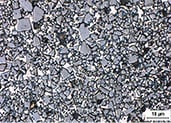 GC-613CT features a coarse grain structure. Coupled with medium binder content, this grade has good wear resistance and can withstand moderate impact loads. The addition of tantalum carbide gives GC-613CT added lubricity and resistance to galling in all wear areas. A corrosion-resistant additive provides resistance to leaching of the binder metal.
GC-613CT features a coarse grain structure. Coupled with medium binder content, this grade has good wear resistance and can withstand moderate impact loads. The addition of tantalum carbide gives GC-613CT added lubricity and resistance to galling in all wear areas. A corrosion-resistant additive provides resistance to leaching of the binder metal.
GC-613CT is used to make powder metal dies, high impact punches and WEDM blocks.
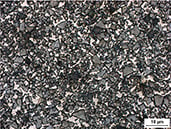 GC-618CT is characterized by its coarse tungsten carbide particles. We make it with high binder content to provide an impact resistant grade that also provides good resistance to fatigue failure. Adding tantalum carbide helps to ensure high resistance to galling, making GC-618CT ideal for metalforming punches, dies and heading die inserts.
GC-618CT is characterized by its coarse tungsten carbide particles. We make it with high binder content to provide an impact resistant grade that also provides good resistance to fatigue failure. Adding tantalum carbide helps to ensure high resistance to galling, making GC-618CT ideal for metalforming punches, dies and heading die inserts.
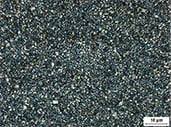 GC-0004 has fine-size particles. Coupled with the low binder content, this grade ensures excellent resistance to abrasive wear. In addition, the presence of tantalum carbide provides high resistance to galling and adhesive wear.
GC-0004 has fine-size particles. Coupled with the low binder content, this grade ensures excellent resistance to abrasive wear. In addition, the presence of tantalum carbide provides high resistance to galling and adhesive wear.
GC-0004 is used to make punches, dies, cutters, forming tools, bushings and miscellaneous wear parts.
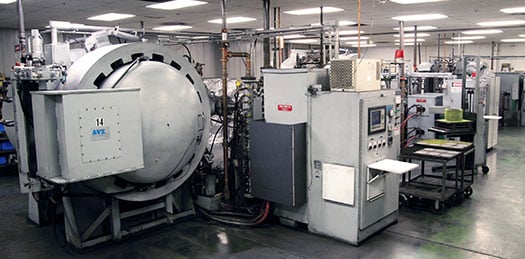
Transforming Powder to Product
After the production of a tungsten carbide graded powder, we press it into shape and consolidate it in a process called Sinter-HIP – Hot Isostatic Pressing (HIP).
This thermal consolidation method involves the simultaneous application of high heat and pressure, resulting in a product that contains little or no porosity and is as close as possible the full theoretical density.
HIP produces a finished product that offers the highest level of reliability. At General Carbide, we guarantee sinter-HIP on all parts processed through our furnaces to ensure superior metallurgical quality.
Subjecting our preforms to sinter-HIPing improves nominal transverse rupture strength, ranging from 400,000-560,000 psi. Our parts and components have little or no porosity and offer superior reliability for applications in automotive, aerospace, heavy equipment, general industry and oil & gas.
The Theory Behind the Practice
According to Weibull’s Statistical Strength Theory, the strength of a brittle material is subject to the presence of a flaw of random size and random distribution located in the area of highest stress. Therefore, a stress concentration of micron size may exist in an area of the material. If it does, the stress concentration will weaken the material.
The theory is named for Ernst Hjalmar Waloddi Weibull (1887-1979), a French-born Swedish engineer, scientist and mathematician. In addition to publishing a paper on the distribution of material flaws, Weibull studied material strength fatigue and rupture in solids. He also wrote a book on fatigue analysis.
The American Society of Mechanical Engineers awarded Dr. Weibull its Gold Medal in 1972. He received The Great Gold Medal from the Royal Swedish Academy of Engineering Sciences in 1978.
In practice, Weibull’s Theory is likely to cause a scatter plot in rupture strength values and the material may fail at stress levels below specification or published strength values. Weibull’s Theory also considers that a size effect exists, meaning the larger the part, the more likely the part will contain pits or other flaws, according to this equation:
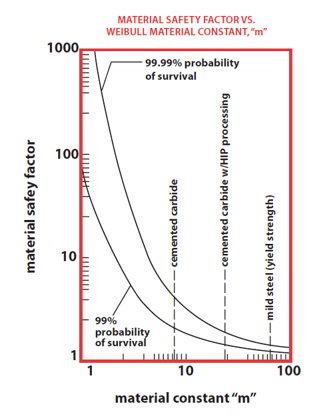 |
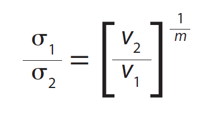 |
|
| This graph shows that to achieve a 99.99% probability of survival, a smaller material safety factor is needed if cemented carbide is processed by sinter-HIP. | ||
Strength depends on specimen volume and will decrease as volume increases.
However, the size effect decreases as the value of “m” (the Weibull “m” material constant) increases. Sinter-HIPing raises the value of the material constant (“m”), thereby reducing the probability of voids, which increases the probability that the material will perform as specified.
Getting back to practical matters, whether you’re an established customer, or you’re looking for a new partner to meet your tooling requirements, we’d like to know what you’re thinking, and how we can help you make the grade.
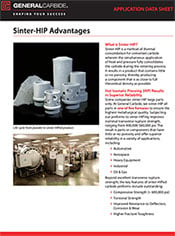
For a detailed explanation of Sinter-HIP as a method of thermal consolidation for cemented carbide, download our Sinter-HIP Advantages applications data sheet.
|




